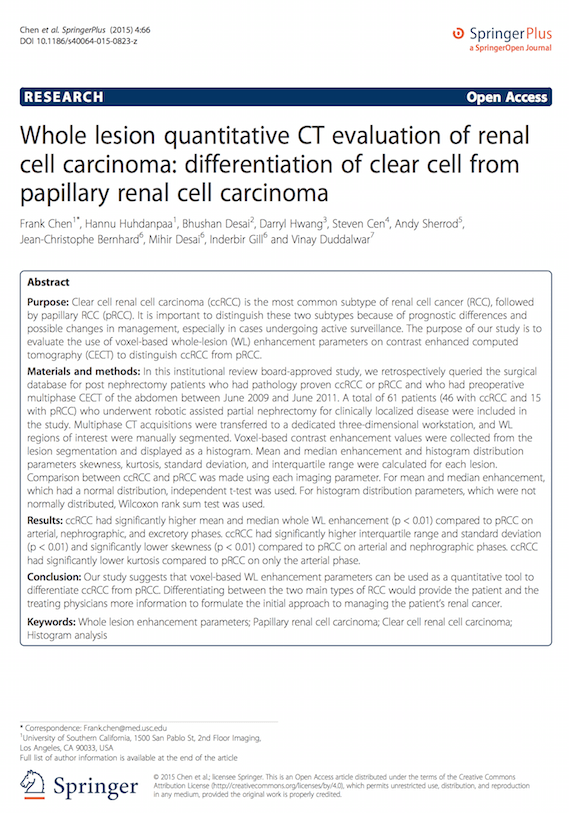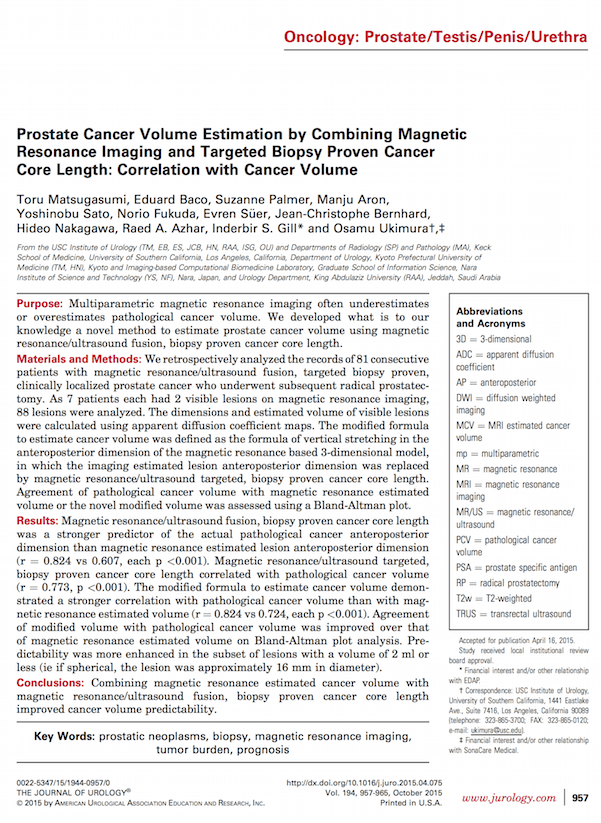BACKGROUND AND METHODS: Nephrectomy is the treatment for renal cell cancer from T1-4 tumors but remains at risk. To determine the thirty-day mortality rate after nephrectomy for cancer and to identify causes and risk factors of death in order to find clinical applications. From 2014 to 2017, we performed a retrospective multicentric analysis of prospectively…
Lire plusVous trouverez dans cette rubrique un aperçu des articles scientifiques publiés par notre équipe ou auxquels nous sommes associés comme co-auteurs.
OBJECTIVES: To evaluate the prognostic role of the Bosniak classification on the long-term oncological outcomes of cystic renal cell carcinomas. MATERIAL AND METHOD: In a national multicentric retrospective study, we included patients treated surgically for localized cystic RCC from 2000 to 2010. Patients with a follow-up of less than 4 years, benign tumors, and ablative treatments…
Lire plusOBJECTIVE. Three-dimensional printing is being used for surgical assistance, particularly for robot-assisted partial nephrectomy (RAPN). The objective of this study was to assess the anatomic accuracy of the 3D model used for 3D model-guided RAPN. SUBJECTS AND METHODS. The study included patients who underwent RAPN aided by 3D printing and anonymized CT. The model, based…
Lire plusOBJECTIVE: To generate a nomogram based on preoperative parameters to predict the occurrence of a major complication within 30-days of robotic partial nephrectomy. MATERIALS AND METHODS: The study included 1,342 patients with a clinically localized renal tumor who underwent robotic partial nephrectomy (RPN) between 2010 and 2017 at 7 academic centers. The primary outcome was…
Lire plusOBJECTIVE: To update the French guidelines on kidney cancer. METHODS: A systematic review of the literature between 2015 and 2018 was performed. The most relevant articles regarding the diagnosis, the classification, surgical treatment, medical treatment and follow-up of kidney cancer were retrieved and included in the new guidelines. The guidelines were updated with corresponding levels of evidence.…
Lire plusBACKGROUND: Multiparametric magnetic resonance imaging (MRI), with or without targeted biopsy, is an alternative to standard transrectal ultrasonography-guided biopsy for prostate-cancer detection in men with a raised prostate-specific antigen level who have not undergone biopsy. However, comparative evidence is limited. METHODS: In a multicenter, randomized, noninferiority trial, we assigned men with a clinical suspicion of…
Lire plusBACKGROUND: Widespread adoption of the AMS-800 artificial urinary sphincter (AUS) in female patients has been hampered by the surgical morbidity of its implantation through an open approach. OBJECTIVE: To describe a standardized technique of robotic bladder neck AUS implantation in female patients, and to report the perioperative and functional outcomes obtained by multiple surgeons with…
Lire plusINTRODUCTION: Despite no consensus on the optimal management of recurrent prostate cancer after primary radiation or HIFU therapy, salvage prostatectomy (sRP) is reserved for only 3% of patients because of technical challenges and frequent post-operative complications. We assessed outcomes after sRP in a series of patients with localized PCa and that had received radiation therapy…
Lire plusINTRODUCTION: To evaluate by junior urologists the morphology of urinary stone using visual endoscopic recognition after expert teaching. Material From December 2017 to May 2018, surface and section stone pictures extracted from digital ureteroscopy had been submitted to description and recognition. Participants could take benefit from an expert coaching. Each stone was evaluated by a…
Lire plusGa-labeled prostate-specific membrane antigen inhibitors and Ga-labeled gastrin-releasing peptide receptor antagonists showed interesting results for staging biochemically recurrent prostate cancer. In this case, Ga-prostate-specific membrane antigen-617 PET/CT, Ga-RM2 PET/CT, and F-choline PET/CT were performed in a patient (66-year-old man, prostate-specific antigen = 6.7 ng/mL) with biopsy-proven Gleason 9 (5 + 4) prostate cancer, candidate for…
Lire plusVoir au format pdf hyperplasie bénigne de prostate, HoLEP, adénome, laser, recommandations
Lire plus














